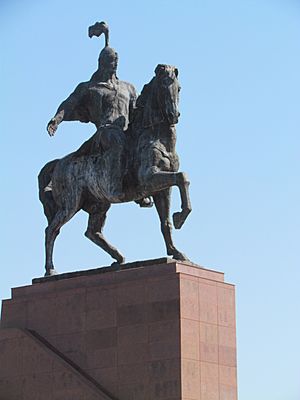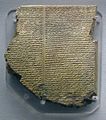Epic poetry facts for kids
Epic poetry is a very long poem that tells an exciting story. It usually has a brave hero and takes place in many different lands. These poems were first told out loud, long before writing existed. They were passed down from person to person through generations.
Beowulf, written in Old English, is a famous example of an epic poem. Other well-known writers of epics include Homer, Virgil, Ovid, Dante, Edmund Spenser, and Milton.
Contents
What Makes an Epic Poem?
Epic poems have special features that make them unique:
- An amazing hero: The main character is usually very important. They might be a historical figure or a legendary hero.
- A huge setting: The story often covers many countries or even the entire known world.
- Brave actions: The hero performs incredibly brave deeds. These actions often require superhuman strength or courage.
- Supernatural help: Gods, angels, or even demons often get involved in the story. They might help or challenge the hero.
- Special writing style: Epics are written in a very formal and poetic way. They use special language and rhythm.
- Objective poet: The person telling the story tries to stay neutral. They don't usually share their own feelings about the events.
- Belief in the story: Both the hero and the villain in the poem believe that the supernatural parts of the story are real.
How Epic Stories Are Told
Epic poems also follow certain traditions in how they are told:
- Starting with the main idea: The poem usually begins by stating its main theme or subject.
- Calling on a Muse: In epics from ancient Western cultures, the poet often asks a "Muse" for help. A Muse is one of the nine daughters of Zeus in Greek mythology. The poet prays for divine inspiration to tell the great story well.
- Starting in the middle: Many epics begin in medias res. This means the story starts in the middle of the action. Often, the hero is at a very difficult point. Flashbacks are then used to show what happened earlier.
- Long lists: Epics often include long lists of objects, places, or people. These lists help show how the story fits into a bigger, universal picture. They can also honor the ancestors of the audience.
- Formal speeches: The main characters often give long, formal speeches.
- Epic similes: These are very long and detailed comparisons. They help describe something by comparing it to something else in a grand way.
- Repeated phrases: Epics often use the same phrases or descriptions over and over. This helps with memorization when stories were told orally.
- Heroic ideals: Epics show important values like courage, honor, sacrifice, and kindness.
- Cultural snapshot: An epic poem gives a clear picture of what life was like when it was written. For example, Beowulf shows a love for feasts, celebrations, war, and sea voyages.
Famous Epic Poems
Here are some well-known examples of epic poems from different times:
Ancient Epics
- 20th to 10th century BC:
- Epic of Gilgamesh (from Mesopotamia)
- 8th century BC to 3rd century AD:
- Mahābhārata (from Indian mythology)
- 8th to 6th century BC:
- Iliad and Odyssey, believed to be written by Homer (from Greek mythology)
- 1st century BC:
Medieval Epics
- 8th to 10th century AD:
- Beowulf (written in Old English)
- 12th to 13th century AD:
- Sirat Bani Hilal (written in Arabic)
- 10th to 12th century AD:
- Njál's saga (from Old Norse)
- 14th century AD:
- Sir Gawain and the Green Knight (written in a dialect of middle English)
Modern Epics
- Omeros (1990), by Derek Walcott
- Empire of Dreams (1988), by Giannina Braschi
See also
- Lyric poetry - a different type of poem that focuses on feelings and emotions.
Images for kids
-
Tablet containing a fragment of the Epic of Gilgamesh
-
The first edition (1835) of the Finnish national epic poetry Kalevala by Elias Lönnrot
 In Spanish: Epopeya para niños
In Spanish: Epopeya para niños




